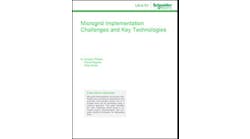Earthquakes? Winter Storm? No Problem for the Redwood Coast Energy Authority Microgrid
When dignitaries and community members came together last June to celebrate the launch of the Redwood Coast Airport Microgrid, little did they know that the first fully renewable, front-of-the-meter, multicustomer microgrid in the state of California would be tested thoroughly this winter.
Located in Humboldt County on California’s northern coast, the 2.25-MW solar microgrid was designed to provide resilience to the county’s regional airport, a neighboring US Coast Guard Air Station, the county animal shelter and nearly 20 other customers adjacent to the airport. The microgrid includes an 8.8-MWh battery storage system and electric vehicle chargers that can be used for demand response.
The first test: A major earthquake
The microgrid faced one of its first major tests early in the morning Dec. 20, 2022, when a 6.4-magnitude earthquake rocked the region. More than 70,000 customers in Humboldt County lost power.
“It was basically a real-world test of a worst-case scenario,” said Matthew Marshall, executive director of the Redwood Coast Energy Authority, the community choice aggregator that owns the microgrid.
Marshall said the quake hit shortly after the batteries discharged to the grid during the evening peak, so they were at their low point of charge.
Plus, there had been very little solar generation that day because of weather conditions, which had been overcast and rainy.
It was also the shortest day of the year and a portion of the solar array was down for commissioning-stage equipment modification work.
“All that added up to our ‘what’s the worst possible timing for an outage’ scenario,” Marshall said.
Critical services maintained
Marshall reported that the microgrid performed better than projected.
The transition to island mode was seamless, and Marshall said the microgrid ran for about 15 hours before power was restored.
Millisecond-scale look at the airport's microgrid transition after the Dec. 20, 2022, earthquake. Source: Schatz Energy Research Center
As a result, the airport was able to maintain normal operations in the aftermath of the earthquake. It also allowed county staff to focus on other critical tasks rather than having to manage backup generators at the site.
Winter storms pummel the region
The microgrid has been called into service to provide power multiple times since the earthquake because of winter storm related outages. On Jan. 6, the microgrid ran for about eight hours until power was restored to the airport, according to Marshall.
It has also provided power during many shorter weather-related outages this month, sometimes operating for less than 30 minutes and other times running for several hours.
The microgrid powered a US Coast Guard air rescue
One of the microgrid’s many customers is a US Coast Guard Air Station located adjacent to the airport. The microgrid is designed to power the air station’s critical functions, including the telemetry that its pilots rely on to fly their missions and rescue operations.
Marshall said that during one of the recent microgrid islanding events, the Coast Guard was able to perform an air rescue, thanks in part to the electricity provided by the microgrid.
Lessons learned
The one-two punch delivered by the earthquake and subsequent winter storms has prompted Redwood Coast Energy Authority to adjust its operating protocols.
“We are going to work on refining our communications plan for keeping the airport and Coast Guard updated on the status of the system,” Marshall said.
To prolong operations in cases where the outage lasts longer, the authority is also going to re-evaluate its load shedding protocols for noncritical, low priority loads during the winter when solar output is limited.
Marshall said one change it deployed immediately was an adjustment to the minimum state of charge when there is a likelihood of outages.
“I think the only difference in responding to the storms versus the earthquake is that we know the storms are coming so we’re able to adjust the operating protocol when grid-connected to maintain the battery at a higher state of charge,” Marshall said.
The energy authority will now hold battery capacity at a 60% minimum reserve to be prepared for potential outages, rather than letting it go down to around 25% during energy market participation.
“Of course, that only works for weather,” Marshall said. “You can't anticipate an earthquake the day before.”
Track news about the Redwood Coast Airport Microgrid. Subscribe to the free Microgrid Knowledge Newsletter.









